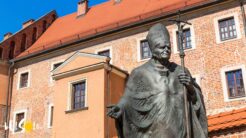Millions of pilgrims are drawn to the Vatican every year, wanting to see some of the most famous buildings of our culture and civilisation, to pray or to see the Pope. Many may wonder why the Vatican of all places is home to the Holy See. Was Jesus ever in the Vatican? If not, why is the Vatican the residence of the Holy See?
Did Jesus ever come to the Vatican?
There’s no evidence that Jesus of Nazareth ever visited Rome or the ground on which the Vatican was then built. It would be frankly quite impressive from a logistical standpoint if he did. Nazareth to Rome is, after all, more than 1,400 miles in a straight line. He would have to travel about 2000 miles through what we now know as Lebanon, Turkey and then get there by boat from Albania to Italy. So no, no matter what funky Karnataka preachers may propose, Jesus was not born in the Vatican, nor did he ever take a 2,000 mile trip there.
There’s also the assumption that Jesus must have been in Rome given that the Scala Sancta staircase (the Holy Stairs) is here. This is, after all, the set of stairs through which Jesus was led to court. The staircase, however, was brought to Rome from Jerusalem in 326. This was done by St Helena, mother of the Emperor Constantine.
Why is the Vatican the home of the Popes?
So what’s the deal with the Vatican? Firstly, it’s not actually the first formal residence of the Pope – before, this was the Lateran Palace, gifted to the Bishop of Rome in the 4th century AD. This remained the habitual resting place for Popes for roughly a thousand years. The Vatican City only came to be as an independent state in 1929.
The argument for why the Vatican City became the ground of the Roman Catholic Church is that it’s built over the grave of Saint Peter, the first bishop of Rome (effectively the first pope). He is believed to have been crucified upside-down on Vatican hill, for he did not deem himself worthy of dying in the same way as Jesus. The Vatican Hill is now the location of Saint Peter’s Basilica, with the tomb of St Peter below the high altar.
See also:






